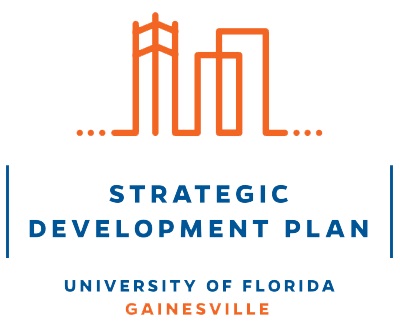 After hundreds of interviews with local residents, the University of Florida took the next step toward forging a shared vision with the Gainesville community when it revealed the findings of its strategic development process.
After hundreds of interviews with local residents, the University of Florida took the next step toward forging a shared vision with the Gainesville community when it revealed the findings of its strategic development process.
“The future of the university hinges on the future of the surrounding community, and vice versa,” said Charles Lane, UF’s senior vice president and chief operating officer, who oversaw the nine-month process. Lane described the results at a meeting at Emerson Alumni Hall on Thursday.
In December, UF’s Board of Trustees asked the university to put its campus master plan in context of the surrounding community, kicking off the strategic planning effort. UF partnered with Boston-based firms Dumont Janks and Elkus Manfredi on the process, which began in February and included 97 interviews with community members, 114 interviews with UF stakeholders, eight public meetings and a symposium drawing on the experiences of universities and towns from Ohio State to the University of Virginia.
Some of the plan’s recommendations will be put into action immediately, while others might not be fully realized for decades.
“Significant changes don’t just need a plan, they need a vision,” Lane said. “We’re not planning for the people in this room, but for generations yet to come.”

The plan recommends four initiatives for UF and the community to focus on when crafting the future of the university and city:
NEW AMERICAN CITY
Aligning the city and university could turn Gainesville into a proving ground for solutions to challenges facing cities nationwide. The plan calls for creating a joint planning group and a “Smart City Lab” to gather and analyze data to inform future decisions. It also suggests leveraging the expertise of UF researchers to address local issues and establishing an investment strategy to translate UF research and ideas into local start-ups. Finally, the plan recommends evaluating ways to establish a presence in downtown Gainesville for some of the university’s programs, especially its cultural amenities.
To support this initiative, UF is providing $250,000 in community research awards to help connect UF’s talent to community issues.
PROXIMITY
To enhance collaboration and innovation, the university will concentrate future development in the eastern third of campus and coordinate with the city to encourage development between downtown and campus. Increasing density in these areas will foster interdisciplinary discovery as well as sustainable growth. The plan recommends studying transportation and parking, the best uses for existing space, facilities maintenance and growth, and ways to make Newell Drive a core connection between UF’s academic core and medical center. Because living on campus supports student success, the plan also calls for re-evaluating the current student housing situation with a residential life plan that includes a strategy for the city’s student housing stock. The housing discussion will extend to creating a strong urban core that enhances neighborhoods, attracts talent and investment and makes it feasible for faculty and staff to live close to campus.
Immediate plans to support this initiative include renovating the Plaza of the Americas and redesigning Newell Drive, which will open up the road as a main artery to further unite the UF campus with Gainesville.
STRONG NEIGHBORHOODS
The plan recommends that the university and city collaborate to preserve historic neighborhoods, creating a diverse housing stock and improving amenities while defending them from gentrification. The city-university collaboration would also examine the east-west corridors connecting downtown and campus, University Avenue, Southwest Second Avenue, Southwest Fourth Avenue and Archer Road/Depot Avenue, investigating fixed-route transit options and revisiting the master plan for Innovation Square with the goal of promoting interaction, connection and future development. The plan also calls for improving the identity of Southwest 13th Street as a gateway to campus and the city, evaluating existing regulations with an eye toward defining appropriate height and density for development, and promoting better relations between student and other residents of neighborhoods near campus by catalyzing housing diversity between campus and downtown.
In support of this initiative, UF will enrich neighborhoods with a $50,000 College of the Arts/city arts initiative. UF will also earmark a portion of the $250,000 community research awards and explore further monetary and talent resources to help preserve and strengthen neighborhoods.
STEWARDSHIP
When the consultants studied what people like about Gainesville, outdoor spaces emerged as some of its greatest attractions. It’s also part of UF’s land-grant mission to be a good steward of the environment on and around campus. With that in mind, the plan recommends studying open space, landscaping, street and utility networks, stormwater and other infrastructure, and partnering with the city on large-scale open spaces, bike-pedestrian trails and stream-corridor restoration to advance the region’s ecological health and outdoor amenities. Recommended collaboration with the community extends to energy, water, waste and recycling issues as well as healthy food initiatives with the local agricultural community.
Immediate plans to support this initiative include the creation of a UF landscape master plan and providing $50,000 to identify solutions that will address a UF/city/county environmental issue.
The next step is to form a group of city and campus representatives to begin creating a shared future for Gainesville and UF.
“This process is not going to stop when our consultants leave,” Lane said, “it’s going to begin.”
